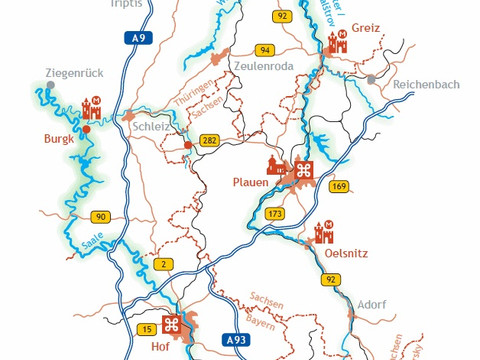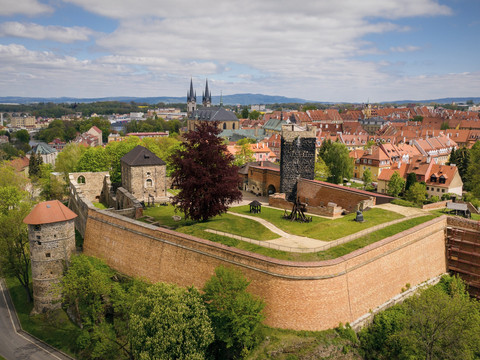The main route along the Cultural Trail enables you to visit the highlights of historical buildings from the Reeves’ period in three days.
Our journey of discovery starts in the northern part of the Vogtland region, in Gera. We delve into the past during a visit to St Mary’s Church with its famous winged altar. It is then possible to enjoy a panoramic view of the contemporary city from the keep of Osterstein Castle, the remains of the medieval fortress.
We then make our way to the birthplace of the Vogtland region: to Weida and Wünschendorf. The Reeves founded the centres of their worldly and spiritual rulership here in the shape of Osterburg Castle and the Mildenfurth monastery in the 12th century. Wünschendorf is also home to the oldest church in the Vogtland region, St Veit’s.
The first day of the journey ends with an evening stroll in the former royal residential town of Greiz. The Upper Castle is the landmark that gives the attractive landscape in Greiz its typical character in the White Elster river valley. An exciting exhibition inside the castle provides visitors with a greater understanding of its historical beginnings. A Romanesque double chapel with several different floors was unearthed during archaeological excavations – an impressive status symbol for the Reeves.
It is really worthwhile making a detour along the river Göltzsch to Mylau from Greiz the next day. It is home to the best-preserved medieval castle in the Saxon part of the Vogtland region. It now houses the new information centre for the Vogtland Reeves’ Cultural Trail and a cultural history exhibition that is worth seeing.
We then go west to Schleiz. The magnificent hill church above the town can definitely tell some stories about the last 800 years.
Burgk Castle nearby, in the most westerly part of the Vogtland region, is an attractive destination for tourists, if for no other reason, because of its unique location. The elaborately restored Silbermann organ in the artistically designed prayer chapel is worth seeing inside the building.
The Cultural Trail now takes us along the river Saale to neighbouring Upper Franconia. The Reeves of Weida formerly developed Hof into a medieval town. What is now the “Bavarian Vogtland” Museum was once part of a monastery.
Having passed through the Burgstein region with its romantic churches and legendary places of pilgrimage, our journey then continues to Plauen, the cultural centre of the Vogtland region. Plauen is rich in remains from the Reeves’ period. The former monastery building used by the Teutonic Order is one of the oldest walls in the town. It is situated right next to St Johannis Church, which marked the founding of Plauen as a town when it was built in 1122. The remains of the old town fortifications, which it is very easy to imagine as far as the Malzhaus, are worth seeing too. There is a wonderful view towards the historical old town from the newly built viewing platform next to the Reeves’ former castle.
Our journey then takes us further south to the former Egerland district, which is now in the Czech Republic, via Oelsnitz. Voigtsberg Castle there offers its visitors alternating exhibitions and regular events.
Seeberg Castle near Františkovy Lázně is attractively embedded in the landscape. The Reeves never lived here. The small fortress was inhabited by faithful vassals, who helped to protect the territory around the town of Eger from attacks. There is an interesting cultural exhibition there, which allows visitors to discover plenty about the lives of the people in the region.
Crossing over a small bridge, we reach St Wolfgang’s Church nearby. Valuable art treasures, which are now exhibited in the Gallery of Fine Arts in Cheb, formerly had their place in the church and the castle itself.
St Nicholas Church dominates the historical centre of the town with a sense of pride and power. We can follow in the footsteps of the Reeves at the imperial palace in Eger, a powerful fortress, the roots of which go back to the 13th century; it also has a wonderfully preserved double chapel. The Reeves operated in Eger as representatives of the Bohemian royal family. Two Heinrichs of Weida probably lived in the old imperial palace and ruled the town for the Bohemian king.
Our journey following in the footsteps of the Reeves ends at the imperial palace in Cheb.
The historical Vogtland region between Thuringia, Saxony, Bavaria and the Czech Republic is rich in old stories and legends. There are fortresses, castles and churches to discover. This cultural landscape encourages people to make their way through it and experience it.









